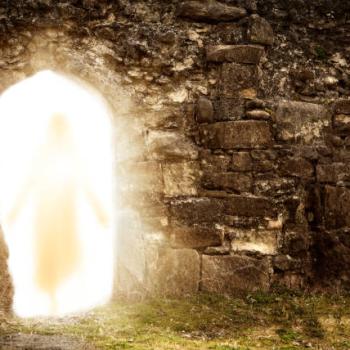
One of the things the Church should be able to teach the secular world is how to lament one’s sins. The Church believes in both sin and lamentation. This is actually the perfect time, when the Church’s sins are so great, for the Church to demonstrate that lesson. But now I’m thinking about two anniversaries we observe this week: the first and second (and only so far) uses of atomic weapons as an act of war. America desperately needs to lament, repent, and make amends for the bombing of Hiroshima and Nagasaki.
Lament
As a fifth grade teacher, I read Sadako and the Thousand Paper Cranes, a historical novel by Eleanor Coerr, to my students. For me at least, it was a lamentation experience. Sadako was a young girl of Hiroshima at the time of the first atomic bomb. She survived the blast, but radiation sickness (leukemia) killed her after 10 years. The story revolves around a Japanese legend. It says that if a sick person folds 1000 paper cranes, the gods will make her well again.
Here is another example of a lamentation. The Hiroshima Wind Orchestra is playing an excerpt from “Lamentation of Arachangel Michael” by Gemba Fujita.
Literature and music express the object of our lamentation better than mere facts, but I will try to give some of the facts. The Atomic Archive estimates total casualties, dead and injured, from both bombings at about 200,000. These include 66,000 Hiroshima deaths and 39,000 in Nagasaki. I’m guessing that these figures represent only immediate casualties.
Dr. James Yamazaki was a UCLA professor and lead physician of the U.S, medical team surveying effects of the bombs. He tells about more deaths, close to 200,000 in both cities by December of 1945. That was only four months after the bombings. His report includes an estimate of still later deaths attributed to the bombs. By 1950 340,000 had died as a result of the two bombs. Of the total only 150 were Japanese military.
These bare figures give only the beginning of an understanding. The following, and much more, can be found in Dr. Yamazaki’s report.
From “Children of the Atomic Bomb”
From their own observations and from testimony of Japanese, members of the survey team divided the morbidity and mortality of the atomic bombs that were dropped on Japan into the following phases:
- Very large numbers of person were crushed in their homes and in the buildings in which they were working. Their skeletons could be seen in the debris and ashes for almost 1,500 meters from the center of the blast, particularly in the downwind directions.
- Large numbers of the population walked for considerable distances after the detonation before they collapsed and died.
- Large numbers developed vomiting and bloody and watery diarrhea (vomitus and bloody feces were found on the floor in many of the aid stations), associated with extreme weakness. They died in the first and second weeks after the bombs were dropped.
- During this same period deaths from internal injuries and from burns were common. Either the heat from the fires or infrared radiation from the detonations caused many burns, particularly on bare skin or under dark clothing.
- After a lull without peak mortality from any special causes, deaths began to occur from purpura, which was often associated with epilation, anemia, and a yellowish coloration of the skin. The so-called bone marrow syndrome, manifested by a low white blood cell count and almost complete absence of the platelets necessary to prevent bleeding was probably at its maximum between the fourth and sixth weeks after the bombs were dropped.
Repentance
No American in government has ever issued an apology for the bombs dropped on Hiroshima and Nagasaki. Over 50 percent of Americans think the bomb was not wrong but necessary.
On the contrary, Catechism of the Catholic Church (# 2314) and the Second Vatican Council in Gaudium et Spes (# 80), state:
Any act of war which aims indiscriminately at the destruction of entire cities, or of extensive areas along with their inhabitants is a crime against God and man himself. It merits unequivocal and unhesitating condemnation. (# 80)
Were we aiming for indiscriminate destruction? A report I read said the bomb missed its target area by only 100 feet. If you’re aiming at a military target and you miss miss by 100 feet, that’s way off. But if your intention is to cause as much destruction of lives and property as possible, 100 feet is close enough.
Notice the Church documents concern the morality of the act itself. Most people only look at consequences; they’re consequentialists. They say we had to do it, or the result would have been even worse. The Church, with all the authority it can muster, says that’s a kind of relativism. But religious authority is not as convincing as it once was. (And that may be a good thing.) So how convincing is the argument that the bombing was necessary for whatever purpose?
Was it necessary?
In 1963 General Dwight Eisenhower said:
The Japanese were ready to surrender and it wasn’t necessary to hit them with that awful thing.
In 1946 Harry Truman ordered an analysis. This “Bombing Survey” concluded:
Based on a detailed investigation of all the facts and supported by the testimony of the surviving Japanese leaders involved, it is the Survey’s opinion that certainly prior to 31 December 1945 and in all probability prior to 1 November 1945, Japan would have surrendered even if the atomic bombs had not been dropped, even if Russia had not entered the war, and even if no invasion had been planned or contemplated.
Admiral William Leahy, Truman’s chief military advisor, wrote in 1950:
It is my opinion that the use of this barbarous weapon at Hiroshima and Nagasaki was of no material assistance in our war against Japan. The Japanese were already defeated and ready to surrender because of the effective sea blockade and the successful bombing with conventional weapons.
Obviously others thought the bombings were necessary. Even more obviously, no one knew for sure. The decision to drop the bomb was a guess. Oddly, in my history classes I learned all about why it was “necessary,” but nothing about the uncertainty of such a calculation? My guess: Americans don’t deal well with uncertainty or with our national sins.
On May 27, 1916, President Obama made a historic visit to Hiroshima. He expressed sympathy for the victims of the bombing, but did not apologize. Maybe some year enough Americans will have the courage to look honestly at our history. Maybe then the Japanese people will get the apology they deserve.
Amends
Lamentation leads naturally to repentance and then to a firm purpose of amendment. We make amends, as far as we can, for the damage our sinful conduct caused. And we amend our lives, that is, resolve not to do it again. In the years since Hiroshima and Nagasaki, I’d say we have done the first. We helped Japan return to prosperity, whether we intended it as amends or as a move in self-interested foreign relations.
The rest of this post examines the extent to which we may or may not have amended our behavior. A pretty strong negative indication is this: America has never said it would not use nuclear weapons again. In fact, we reserve the option even of using them first.
Deterrence
What keeps countries from using nuclear weapons first is the assurance of a retaliatory nuclear strike and the unacceptable damage that would entail. The name for this game is deterrence. Over the years the Church has questioned the morality of deterrence. The morally odd thing about it is that any use of a nuclear weapon near a population center is immoral according to traditional just-war theory. That applies even to a retaliatory strike. If an enemy destroys your cities, you can’t destroy theirs in return, morally. So the strategy of deterrence involves convincing an enemy that you are willing to act immorally.
In several statements by popes and bishops, the Church has provisionally accepted the strategy of deterrence. The proviso is that nations must be working seriously toward the elimination of these weapons of mass destruction. More recently Pope Francis has disavowed even this provisional acceptance. “The threat of their use as well as their very possession is to be firmly condemned,” the pope told participants at a conference on nuclear disarmament hosted by the Vatican.
The pope was responding to one simple fact: The countries in the “nuclear club” have not worked seriously at eliminating nuclear weapons. That’s especially true of the U.S. Over the years we have, instead, led the way in the nuclear arms race. We’ve been the first to develop and deploy practically every advance in nuclear weapons technology, including some that made deterrence less stable.
Troubled nuclear arms agreements
The Arms Control Association lists agreements, between the U.S. and the Soviet Union, to reduce nuclear arms. Strategic Arms Limitation Talks (SALT I and SALT II) produced significant agreements. They capped the numbers of missile silos, submarine launch tubes, and nuclear equipped bombers, but not the number of bombs. The U.S., followed by the Soviet Union and other countries, developed technology to deploy up to 16 warheads on one delivery vehicle. Each could destroy a different target. An anti-ballistic missile agreement (ABM) limited missile defenses. For deterrence to work it was necessary that a country not be able to defend against a nuclear attack.
In 2002 President Bush withdrew the U.S. from the ABM treaty. The SALT II agreements were never ratified by Congress. The U.S. and the Soviet Union abided by their terms, anyway; but President Regan disavowed them in 1986.
Strategic Arms Reduction Treaties (START I and START II) of the early 1990’s were more ambitious. They would have reduced both delivery systems and warheads. START I reductions were completed in 2001, but the treaty expired in 2009. START II would have made further reductions, but it was never ratified partly because of the U.S. withdrawal from the ABM treaty.
In 2010 the United States and Russia signed New START. It mandated lower limits than before. Both sides met the treaties main limits before 2018.
New START and the other treaties’ limits applied to long-range, Intercontinental Ballistic Missiles. Another agreement limited intermediate range nuclear forces. These would be weapons stationed closer to potential targets in Europe. Each side accused the other of non-compliance. President Trump terminated this treaty on August 2. He also threatens to withdraw from the New START treaty when it expires in 2021.
Going backwards
In November of last year, the Vatican hosted a conference on disarmament with U.N. and NATO leaders and 11 Nobel Peace Prize laureates in attendance. The previous July a U.N. treaty called for the complete elimination of nuclear weapons. One hundred twenty-two nations signed it, including Vatican City, but not any of the world’s nuclear powers. There were no nuclear powers at the Vatican conference, either. At this conference Pope Francis changed the Church’s position from conditional acceptance of nuclear deterrence to condemnation of nuclear weapons possession, period.
Had the nations met the Church’s previous condition of serious work on eliminating nuclear weapons? Stockpiles definitely have been reduced, but from insanely high numbers to only very high numbers. Nations can still destroy each other many times and still rely on that mutually assured destruction as much as ever. Both Russia and the United States are in the process of modernizing, if not expanding, their nuclear weapons systems.
The Bulletin of Atomic Scientists describes the world’s security situation as a “new abnormal.” Their concerns include, among others:
- Misrepresentation of facts and information warfare,
- Vanishing confidence in political structures and scientific inquiry,
- Increased tensions resulting from climate change,
- The abandoning of the Iran nuclear deal by the United States, and
- Nuclear modernization that is “all but indistinguishable from a worldwide arms race.”
The famous Doomsday Clock expresses these scientists’ conclusions about the danger facing our world. It is now set at two minutes to midnight, the closest it has ever been. One could say that the Pope’s complete condemnation of nuclear weapons, their use, the threat to use them, even possessing them, comes at the 58th minute of the 23rd hour of the day. It is not too soon for the world, especially the United States, with Hiroshima and Nagasaki on our conscience, to learn about sin, lamentation, repentance, and the firm purpose of amendment.
Image credit: CNN.com via Google Images












